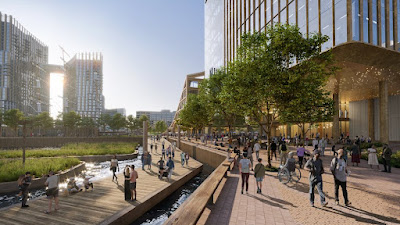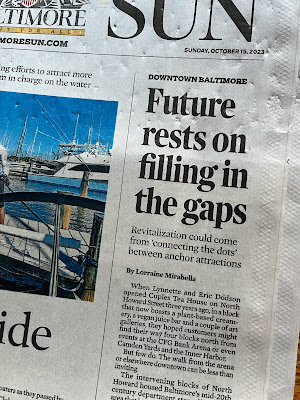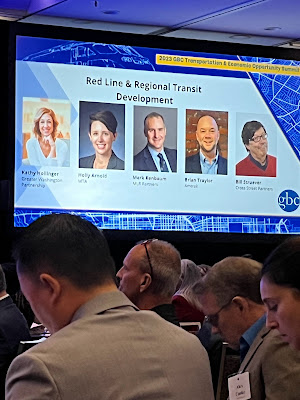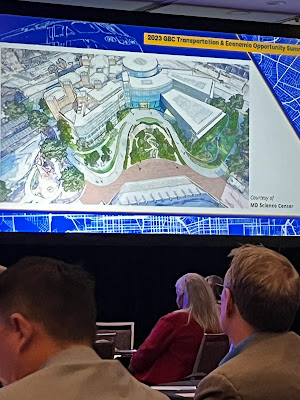"The full weight of city government is ready to make this a reality. We won't stop until this project comes to fruition" (Mayor Brandon Scott)
In my previous article written right after David Bramble had pulled his giant HarborPlace rabbit out of the hat, I wondered how the Mayor could be so committed on a proposal that even insiders had known for only 48 hours. |
| Brandon Scott and the Governor at the unveiling of theDesign (Photo: Philipsen) |
Let's assume for a moment that the project would indeed be what the Mayor assumes when he wants "this project come to fruition" and that the program, the design and the execution by this team, lock-stock and barrel, would be the optimal choice. For sake of argument, let's set aside qualms about the high-rises or the question why giving a developer public parkland for for-profit development is the height of brilliancy.
 |
| Proposed design: Rabbit out of the hat (MCB rendering) |
Three bills 0444, 0446 and 0448 introduced by councilman Costello are supposed to remove the obstacles on the path to success. The bills were heard by the Planning Commission on 11/30. A vote was postponed until 12/21 because of the difficulties to get the online participants to see the proceedings.
This delay gives everyone a chance to mull this over. The bills are intended to create the zoning necessary to permit the proposed size of the project which cannot be built with the existing Urban Renewal Plan and current zoning in place. Because the plan includes parkland conversion, it requires a charter amendment, which has to go to referendum during the election in 2024. Planning Commission and Council approval are the necessary steps needed to place the issue on the ballot.
For sake of argument let's further assume that the bills would pass all hurdles and voters would approve them next November. Will that get the project built as envisioned? Clearly not! A project of this magnitude doesn't materialize over night. But will the bills, which open the floodgates by removing all controls, ensure that the project doesn't veer off the rails? Unfortunately, no. The bills don't contain any assurances and safeguards for the project to happen as imagined. In other words, the removal of controls could yield outcomes that could potentially be vastly different from what Bramble's renderings show.
No other places were such conditions would or should be installed are in progress or in sight right now. The necessary land transactions could be such a venue but it would be helpful to know now how that process would shape up. Once the horse it out of the barn without reigns, it will be much harder to get it back in. This laissez faire approach is astounding, since by owning the land and having very restrictive zoning in place, the City right now has full leverage to control what will happen.
 |
| Redesigned Rash Field: unmitigated Success (Photo: Philipsen) |
Bramble's MCB currently has only limited development rights on the two pavilions which the developer bought in foreclosure for a price that would have been at most 1/20th of the total cost the currently proposed project, even though the project is also burdened by "significant" unpaid debt as Councilman Costello pointed out to me. "That debt needs to be dealt with before anything can happen", Costello says. "Unlike when Harborplace was first built, this land is not being given away for free". To call this is a give-away would be "patently false", he maintains.
Still, the City stands to give its entire leverage away including height, massing, use restrictions and limitations on the maximally allowable development footprint; all out the window should the bills pass. At this point it may be useful to recall that zoning was invented to protect the public.
Let's just imagine a few scenarios how things wouldn't go as imagined:
- MCB doesn't get the financing for the estimated $490 million and runs out of resources to build the project and either builds a stripped down cheap version or walks away all together
- MCB decides to partner with another developer or sell the pavilions to another entity which has vastly different ideas and ideals. This new entity would obtain full rights without any meaningful restrictions
- MCB is doing everything right but the City never finds the money to do the public improvements shown on Bramble's renderings. They alone are estimated by MCB to cost another $400 million. Likely Bramble's project would be dead in the water without the additional land that comes from realigning Light and Pratt Streets.
- Alternatively, the City never gets around to doing the parks, streetscapes and new alignments but MCB finds a way to still stick their buildings on the land, i.e. Baltimore would get the buildings but not the amenities. A bad deal.
There are plenty of examples that demonstrate how difficult the process of getting a large project out of the ground is these days. For any developer.
 |
| How “ the frame” works today: The tall guys stand back. (Photo Philipsen) |
Port Covington is a valuable lesson. It tells us that beautifully drawn ambitious renderings can easily be tossed aside when circumstances require cheaper and more expeditious solutions, as long as they are are allowed within the framework of the deal.
In the case of the Port Covington TIF commitment, the City put a slew of conditions in place, about the public promenade, community benefits and about streetscape standards which whatever developer is held to. And even with those conditions in place, the development will never look like the original renderings of Under Armour's headquarters. What is being under construction now is just a shadow of was once envisioned, even if that may be for the better in this case.
Other examples of things not going to plan aplenty: Simply look at the arduous saga of Madison Park North, another MCB project now called Reservoir Square. It goes back as far as 2014, then under a different ownership. The project had many starts and stops and design changes along the way. Or take the two huge holes in the ground on Baltimore Street that developer Howard Brown has left behind after he demolished the Mechanic Theatre and, two blocks further west, another set of structures. Or look at the former News American site, that has sat as a parking lot on prime land right across from HarborPlace for 40 years. It is now also owned by MCB and destined for a high density development. MCB also owns the 10 story 1 East Pratt Street building, also right across from HarborPlace.
As with the Planning Department's design review panel UDAAP before, the MCB team showered the Planning Commission with all the might of a sales pitch, about the growth of MCB, about access, equity, inclusion and all the public input they received. Absent were the hard facts of a technical site plan showing current and future property lines and all the other facts and figures needed to assess such a complex project. But unlike UDAAP which asked the developer to come back with the right materials, the Planning Commission's delay was a technical mishap, they gave no indication that they objected to the missing details.
Bramble's central argument is that he needs all those apartments "to make the numbers work". This is a completely unsubstantiated argument. What size is needed to achieve what outcome? Bramble says he wants to redefine downtown and that Baltimore has to grow in order to thrive. Few would disagree. But not all of the growth has to be at HarborPlace. Downtown has added over 15,000 residents in recent years, the nearby 500' tall Light Street tower with 394 apartments included. None of them have rescued the two pavilions from their decline. That decline was not the fault of the structures but the result of blatant neglect and mismanagement by the previous owners.
By contrast, the redesigned Rash Field with its skateboard area, playground and overlook became a huge success Existing residents flocked there by the thousands, long before the only small building, a coffee shop even opened. Although I have no doubt that David Bramble has the best intentions and his courageous full-on engagement with an excellent design team is nothing but laudable, his main argument is circular. "I propose a giant project that costs a lot of money so I need unfettered permissions to fund it". One could easily argue that a much cheaper project that focuses on the public spaces and amenities would yield better outcomes.
Bramble's big is better argument would make sense if the large for-profit component would pay for the public improvements that his pretty pictures show, the Freedom Park, the streetscapes, floating wetlands and whatever else one can discover on the drawings (streetcars, some even discovered a cable car). But Bramble has made it very clear: His project won't'pay the public improvements. Those $400 million would have to be paid by taxpayers. And no such amount is in sight.
 |
| The tall guy sits on the playing field. No room for tall ships. The floating promenade and floating wetlands make the water even smaller. (MCB Gensler rendering) |
While the details are murky, it looks like public functions that come with MCB's buildings are limited to a first floor market (that, ironically would likely re-incarnate Jim Rouse's original visions for the pavilions as in Port Covington's envisioned market), possibly a green roof top garden and potentially the stepping gardens on the building called "the Sail" plus the dark tunnel space underneath it.
So what does the public get for the big give-away of rules? This is mostly an unanswered question. Possibly nothing, or very little. Whatever it is, it isn't written into the bills. Maybe the worst case unintended scenario would be the Mechanic Theatre model in which the pavilions get demolished and nothing new gets built at all?
The available documents don't explain which parts of Bramble's plans, if any, would depend on curb realignments of adjacent roadways and what the steps are that are necessary to make those happen. Possibly without zoning restrictions towers could rise without that the land area grows thanks to narrower streets.
Wouldn't the Mayor want to make sure that none of the bad scenarios could happen?
To represent the public interest when it comes to dealing with savvy private developers, the City has the "full weight" of the administration, such as the Baltimore Development Corporation, the Planning Department and all the other departments such as Transportation.
- What does BC-DOT say about cutting Light Street down in size and closing the dogleg connection to Calvert Street?
- What is the Planning Department saying which reportedly is preparing for a downtown masterplan into which Brambles stuff would have to fit?
- What is BDC's cost benefit calculation for the project? The Planning Commission never got to hear any of that because the departments never had the time or the facts to do a proper analysis.
The comments included in the "staff report" of the Planning Department are limited to describing which restrictions are in place today and which would be lifted by the suggested bills. It would be nice to learn if any of the folks know something the public doesn't. But after the Commission's vote was delayed to December 21 due the City's inability to make their WebEx work for the 60 or so people waiting to participate online, neither Commission members nor the administration are allowed to discuss the matter in the interim. All this stands in very stark contrast to the analysis of the Port Covington project leading up to the City TIFF funds. Whatever scrutiny at the time was in large part the result of a big public outcry over Kevin Plank's project and the City support for it.
Our Planning Department and this Planning Commission is engaged in a dereliction of duty for not performing this role for the citizens of Baltimore. You should not even be holding this hearing unless it is to reject the entire plan and this process. The Bramble Plan is a classic case of the-cart-before-the-horse.” (Developer David Tufaro as quoted by Ed Gunts in the Baltimore Fishbowl)
The process questions are key for the success of a reimagined HarborPlace. One would think everyone would agree, especially the City Council representing us, the citizens, the Planning Department advising the Planning Commission and the latter advising the Mayor. I don't think that any of these entities act in bad faith. However, they are either too mesmerized by MCB as the HarborPlace savior or their hands have been tied by the Mayor who wants to wave the project through as quickly as possible. Fact is that the departments have not weighed in with their expertise as they are supposed to.
These are big questions and they are urgent, even before one discusses the other big issue, namely why a private developer should be allowed to stuff massive development on land that, in part, is designated to be open park space in perpetuity.
 |
| Current view from upper pavilion deck (Photo: Philipsen) |
Finally, the last question which we set aside so far is the design question: Why the proposed project should be allowed to violate the fundamental design rules of the long established and successful Inner Harbor Masterplan?
It was created by Wallace Robert Todd half a century ago and, for the most part, stood the test of time. It established ground rules about space, urban design, the interaction of public and private and the visual connections to and from the Inner Harbor.
That old masterplan established an "outer frame" along Pratt and Light Street which defined the space we call Inner Harbor today and which acts in its totality as Baltimore's "Central Park": Water, promenade, adjacent parks and all. It was for decades laying golden eggs.
The Planning Commission chair noted at the beginning of the deliberations that the bills in question were about land use and not about design. These two things can't be separated. The proposed land use, massing and bulk will drastically change how we see the Inner Harbor, literally and figuratively. It will open up some new views and block many others.
Bramble proposed to put his high-rises inside the "outer frame". This means he puts them right into "central park", or, in sports terms, inside the playing field that we call HarborPlace. That Baltimore can play a bigger game on a smaller field is so far just a promise that is hard to believe.
Klaus Philipsen, FAIA
After the initial publication the text was slightly edited for clarity













































